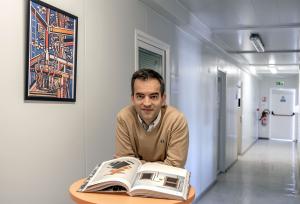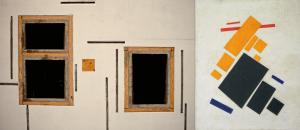Art around every corner
Most of us have experienced it. Turning a corner in one of the Tokamak Building galleries and looking up at the graphic pattern of embedded plates in the concrete walls, or noticing the geometrical arrangement of steel rebar, we have been moved by a sense of beauty and balance—the kind of emotion one feels in front of a work of art.
Oriol Ribas i Escolà is the ITER Project Director at Ferrovial, one the three companies (with Vinci and Razel-Bec) that form the VFR consortium responsible for the construction of the Tokamak Complex and eight other structures on the platform. In the course of his career he has worked on many large civil works projects in the United Kingdom and his native Spain, however what he has experienced at ITER can only be described as an aesthetic "revelation." Progressively, as he monitored the progress of construction, he began to see Malevich paintings, Dan Flavin installations and Donald Judd compositions almost everywhere.
"When I was a kid in post-Franco Spain, a period we call 'the Transition,' I studied in a school that was especially sensitive to artistic expression," he says. "And although I chose to become a civil engineer, something of that early education has stayed with me. After all, drawing is central to civil engineering and you need a sort of flair for geometry, volumes and the occupation of space."
At ITER, Oriol could in some cases instantly draw parallels between the shapes, colours and volumes that caught his eye and an artist or artistic movement. "But at times, it was just something I felt, like a reminiscence that I could not put my finger on."
The encounter in September 2019 with José Manuel Ballester, a renowned Spanish painter and photographer whom Ferrovial commissioned to document its work on the ITER Project for a book commemorating the 70th anniversary of the company's inception, was decisive.
"As someone with a wide artistic culture, he could put names on my perceptions. We shared our awe of the pure artistic beauty of the ITER Tokamak and its environment. It was as if art, and art history, were present at every step."
Oriol began photographing scenes in and around the Tokamak Building. Workers in a steel structure reminded him of Fernand Léger's Les Constructeurs (1950). Dark openings framed in yellow-painted steel were the very shapes and colours of Malevich's Suprematist Composition: Airplane Flying (1915). Reinforcement around the openings of the bioshield was a perfect reproduction of Andy Goldsworthy's Screen (1998). A concrete structure in the neutral beam cell conjured the works of Eduardo Chillida, the mirror-like cladding of the building those of Anish Kapoor, and a neon light on a wall seemed to have been placed there by Dan Flavin ...
In the Tokamak Complex and other constructions, Oriol tracked the legacy of the Concrete and Neo-Concrete movements, of Cubism, Constructivism, Minimalism, Futurism ... as if the ITER worksite had become the largest and most massive modern and contemporary art museum in the world.
When VFR decided to publish a generously illustrated, 300-page coffee table book to celebrate the seven million work hours the consortium has invested in the construction of the ITER Tokamak Complex and auxiliary buildings, Oriol seized the opportunity to explore in an essay what he terms "the fascinating connection between abstract art and construction."
Beyond this exploration however, Oriol pursues a broader objective. "The world of modern and contemporary art is very difficult to penetrate. Most people see it as something quite elitist and snobbish, and do not understand why some of the works they see as absurd and meaningless are celebrated and sold for a fortune. My intention in my humble essay is to make apparent to them the connection between construction and art and contribute, however slightly, to offering a new perception. Also, as the book was originally intended for those who contributed to construction, I wanted them to feel pride for what they achieved."
Oriol views ITER as a "unique masterpiece of artistic construction" and invites us to transgress "the usual perception of concrete and steel structures to unveil their unlikely artistic soul."
As civil works in the Tokamak Complex near completion, the raw art of construction is fast vanishing from view. Soon, our eyes will be caught by other forms, shapes and compositions, but the beauty will endure, whether in the alien shape of a massive component, the complexity of an intricate piece of equipment, or the radiance of a burning plasma.




